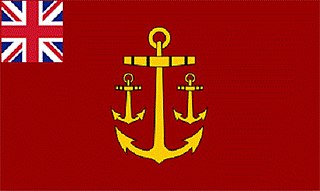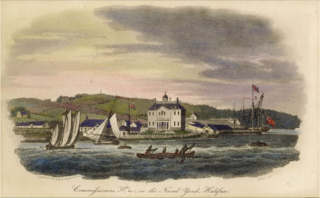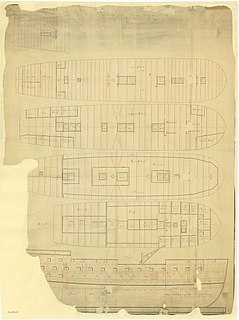
The Navy Board and formerly known as the Council of the Marine or Council of the Marine Causes was the commission with responsibility for day-to-day civil administration of the Royal Navy between 1546 and 1832. The board was headquartered within the Navy Office.

Royal Navy Dockyards were state-owned harbour facilities where ships of the Royal Navy were built, based, repaired and refitted. Throughout its history, the Royal Navy has made extensive use of private shipyards, both at home and abroad; but at the same time it also had a policy of establishing and maintaining its own dockyard facilities. Portsmouth was the first ; it was followed by Deptford, Woolwich, Chatham and others. By the 18th century, Britain had a string of these state-owned naval dockyards, located not just around the country but across the world; each yard was sited close to a safe harbour or anchorage used by the fleet. Most Royal Dockyards had a dual function, providing for both ship building and ship maintenance. Over time, they accrued additional on-site facilities for the support, training and accommodation of naval personnel.

Royal Naval Dockyard, Halifax was a Royal Navy base in Halifax, Nova Scotia. Established in 1759, the Halifax Yard served as the headquarters for the Royal Navy's North American Station for sixty years, starting with the Seven Years' War. The Royal Navy continued to operate the station until it was closed in 1905. The station was sold to Canada in 1907 becoming Her Majesty's Canadian Dockyard, a function it still serves today as part of CFB Halifax.

The Kingston Royal Naval Dockyard was a Royal Navy Dockyard from 1788 to 1853 in Kingston, Ontario, Canada, at the site of the current Royal Military College of Canada.

The Commissioners for the Victualling of the Navy, often called the Victualling Commissioners or Victualling Board, was the body responsible under the Navy Board for victualling ships of the British Royal Navy. It oversaw the vast operation of providing naval personnel with enough food, drink and supplies to keep them fighting fit, sometimes for months at a time, in whatever part of the globe they might be stationed. It existed from 1683 until 1832 when its function was first replaced by the Department of the Comptroller of Victualling and Transport Services until 1869 then that office was also abolished and replaced by the Victualling Department.

HMS Monmouth was a 64-gun third rate ship of the line of the Royal Navy, launched on 23 April 1796 at Rotherhithe. She had been designed and laid down for the East India Company, but the Navy purchased her after the start of the French Revolutionary War. She served at the Battle of Camperdown and during the Napoleonic Wars. Hulked in 1815, she was broken up in 1834.

HCS Bombay, later HMS Bombay and HMS Ceylon, was a teak-built fifth rate, 38-gun wooden warship built in the Bombay Dockyard for the Honourable East India Company (HEIC) and launched in 1793. The Royal Navy purchased her in 1805 and renamed her HMS Bombay. She served with the Royal Navy under that name until 1 July 1808, when she became HMS Ceylon. She was sold at Malta in 1857 and broken up in 1861.

HMS Cornwallis was a Royal Navy 54-gun fourth rate. Jemsatjee Bomanjee built the Marquis Cornwallis of teak for the Honourable East India Company (EIC) between 1800 and 1801. In March 1805 Admiral Sir Edward Pellew purchased her from the Company shortly after she returned from a voyage to Britain. She served in the Far East, sailing to Australia and the Pacific Coast of South America before returning to India. In February 1811 the Admiralty renamed her HMS Akbar. She captured forts and vessels in the Celebes and Amboyna, and participated in the invasion of Isle de France, and the 1811 invasion of Java. She also served in the West Indies before being laid up at Portsmouth in December 1816. She then stayed in Britain in a number of stationary medical and training capacities until the Admiralty sold her in the 1860s.
HMS Wolverine was a Royal Navy 18-gun Cruizer-class brig-sloop, launched in 1805 at Topsham, near Exeter. Early in her career she was involved in two fratricidal incidents, one involving a British frigate and then a newsworthy case in which she helped capture a British slave ship. She later captured a small naval vessel and several privateers, and took part in the invasion of Martinique, and during the War of 1812, in the attack on Baltimore. Wolverine was decommissioned in August or September 1815 and was sold on 15 February 1816.
The Apollo-class sailing frigates were a series of twenty-seven ships that the British Admiralty commissioned be built to a 1798 design by Sir William Rule. Twenty-five served in the Royal Navy during the Napoleonic Wars, two being launched too late.

HMS Salsette was a Perseverance-class fifth-rate frigate of a nominal 36 guns, launched in 1805. The East India Company built her for the Royal Navy at the Company's dockyards in Bombay. She was the Navy's first teak-built ship.

The Glorious Revolution of 1688 rearranged the political map of Europe, and led to a series of wars with France that lasted well over a century. This was the classic age of sail; while the ships themselves evolved in only minor ways, technique and tactics were honed to a high degree, and the battles of the Napoleonic Wars entailed feats that would have been impossible for the fleets of the 17th century. Because of parliamentary opposition, James II fled the country. The landing of William III and the Glorious Revolution itself was a gigantic effort involving 100 warships and 400 transports carrying 11,000 infantry and 4,000 horses. It was not opposed by the English or Scottish fleets.

The Deputy Comptroller of the Navy was a principal member of the Navy Board of the Royal Navy who was responsible for chairing the Committee of Correspondence and managing all internal and external communications of the Navy Board from 1793 to 1816 and then again from 1829 to 1832. He was based at the Navy Office.

The Victualling Department originally known as the Department of the Comptroller of Victualling and Transport Services or the Victualling Office, also known as the Department of the Director of Victualling was the British Admiralty department responsible for civil administration of Victualling Yards and the storing and supply of Naval Victuals for the Royal Navy from 1832 to 1964.

The Navy Office was the government office charged with responsibility for the day-to-day civil administration of the British Royal Navy from (1576-1832). It contained all the members of the Navy Board and various other departments and offices. The day-to-day business of the Navy Office was administered by Clerk of the Acts from 1660 until 1796, who was responsible for the organisation of the office and management of its staff. When his office was abolished his duties were assumed by separate committees for Accounts, Correspondence, Stores, Transports and Victualling who were, in turn, presided over by the Comptroller of the Navy until 1832. It was one of two government offices that were jointly responsible for directing naval affairs. In 1832 following reforms of the naval service the Navy Office was abolished all of its functions and staff were merged within the Admiralty.
Jamaica Dockyard also known as Port Royal Dockyard was a British Royal Navy Dockyard located at Port Royal, Jamaica. It was established 1675 and closed in 1905. The dockyard was initially administered by the Navy Board then later the Board of Admiralty.
HMS Vulture was launched in 1801 at South Shields as Warrior. The Royal Navy purchased her in 1803 as a sloop and renamed her. From 1808 through 1813 she was a floating battery at Jersey,. The Navy sold her in 1814 and she returned to mercantile service as Warrior. She was last listed in 1820, but does not seem to have sailed again after returning from east of the Cape in 1817.

The Resident Commissioner at Trincomalee, also known as the Resident Commissioner of the Navy at Trincomalee, was chief representative of the Navy Board based at Trincomalee Dockyard. He was senior official of the yard responsible for the supervision of the principal officers of the yard from 1810 to 1832.

Bombay Dockyard or formally His Majesty's Indian Dockyard, Bombay was originally a naval facility developed by the East India Company beginning in 1670. It was formally established as a Royal Navy Dockyard in 1811 and base of the East Indies Station when the Department of Admiralty in London took over it. The yard was initially managed by the Navy Board through its Resident Commissioner, Bombay until 1832 when administration of the yard was taken over by the Board of Admiralty, it was closed in 1949.
HMS Comet was launched in 1807 as a Thais-class fireship of the Royal Navy. In 1808 the class were re-rated as sloops, and in 1811 they were re-rated as 20-gun sixth rates. Comet participated in one action that resulted in her crew being awarded the Naval General Service Medal, and some other actions and captures. The Navy sold her in 1815. In 1816 she became an East Indiaman, sailing under a license from the British East India Company (EIC). She sailed between the United Kingdom and Ceylon. It was on one of these journeys that she was wrecked on Cole House Point on the River Thames on 9 August 1828.












